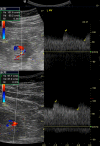Hemodynamic characteristics and the occurrence of renal biopsy-related arteriovenous fistulas in native kidneys
- PMID: 27580732
- PMCID: PMC5031753
- DOI: 10.1007/s11255-016-1411-z
Hemodynamic characteristics and the occurrence of renal biopsy-related arteriovenous fistulas in native kidneys
Abstract
Purpose: Renal biopsy-related arteriovenous fistula (RB-AVF), although usually asymptomatic, may sometimes result in serious clinical implications. The aim of the study was to prospectively evaluate the incidence of RB-AVF in native kidneys, together with the assessment of hemodynamic characteristics and the impact of the histopathological results of biopsy.
Methods: The study included 138 patients (age 46.2 ± 15.2; 70 F, 68 M), who underwent percutaneous renal biopsy (PRB) of the native kidney. In all patients, 2D and color Doppler ultrasound was performed 24 h after PRB in order to exclude RB-AVF.
Results: Bleeding complications in the form of hematomas were found in 136 patients (98.55 %), and 23 cases of RB-AVF were observed (16.67 %). RB-AVF group had an increased maximal hematoma diameter and reduced number of glomeruli in PRB. The segmental arteries supplying the fistulas are characterized by higher maximum flow velocity (FV) and a lower resistance index (RI) compared to the normal segmental arteries (difference 45.9 ± 20.0 cm/s and 0.252 ± 0.104, respectively). In the ROC analysis, RI ≤ 0.524 allowed to detect RB-AVF with a sensitivity of 91 % and specificity of 100 % (AUC 0.998, p < 0.001). In approximately 39 % of RB-AVF cases, 2D ultrasound detected a hyperechogenic ischemic area between the fistula and the renal capsule.
Conclusions: Arteriovenous fistula is a quite frequent complication of native renal biopsy and can cause ischemia in the renal parenchyma detected by ultrasound. The arteries supplying the fistula are characterized by an increased flow velocity and reduced resistance index.
Keywords: Arteriovenous fistula; Renal biopsy; Resistance index.
Conflict of interest statement
Author Arkadiusz Lubas declares that he has no conflict of interest. Author Anna Wojtecka declares that she has no conflict of interest. Author Jerzy Smoszna declares that he has no conflict of interest. Author Piotr Koziński declares that he has no conflict of interest. Author Emilia Frankowska declares that she has no conflict of interest. Author Stanisław Niemczyk declares that he has no conflict of interest. Ethical approval All procedures performed in studies involving human participants were in accordance with the ethical standards of the institutional and/or national research committee and with the 1964 Helsinki Declaration and its later amendments or comparable ethical standards. Informed consent Informed consent was obtained from all individual participants included in the study.
Figures
Similar articles
-
Evaluation of complications due to percutaneous renal biopsy in allografts and native kidneys with color-coded Doppler sonography.Clin Nephrol. 1995 May;43(5):303-8. Clin Nephrol. 1995. PMID: 7634544
-
Arteriovenous fistulae after renal biopsy: diagnosis and outcomes using Doppler ultrasound assessment.BMC Nephrol. 2017 Dec 20;18(1):365. doi: 10.1186/s12882-017-0786-0. BMC Nephrol. 2017. PMID: 29262805 Free PMC article.
-
Timing of Doppler examination for the detection of arteriovenous fistula after percutaneous renal biopsy.J Clin Ultrasound. 2008 Jul-Aug;36(6):377-80. doi: 10.1002/jcu.20459. J Clin Ultrasound. 2008. PMID: 18335514
-
Renal dysfunction due to an arteriovenous fistula in a transplant recipient.J Am Soc Nephrol. 1994 Dec;5(6):1300-6. doi: 10.1681/ASN.V561300. J Am Soc Nephrol. 1994. PMID: 7893994 Review.
-
Renal allograft arteriovenous fistula due to needle biopsy with late onset of symptoms--diagnosis and treatment.Nephron. 1991;59(3):482-5. doi: 10.1159/000186613. Nephron. 1991. PMID: 1758542 Review.
Cited by
-
Kidney biopsy guidebook 2020 in Japan.Clin Exp Nephrol. 2021 Apr;25(4):325-364. doi: 10.1007/s10157-020-01986-6. Clin Exp Nephrol. 2021. PMID: 33606126 Free PMC article. No abstract available.
-
Dynamic tissue perfusion assessment reflects associations between antihypertensive treatment and renal cortical perfusion in patients with chronic kidney disease and hypertension.Int Urol Nephrol. 2018 Mar;50(3):509-516. doi: 10.1007/s11255-018-1798-9. Epub 2018 Jan 27. Int Urol Nephrol. 2018. PMID: 29374813 Free PMC article.
-
Expanding the Role for Kidney Biopsies in Acute Kidney Injury.Semin Nephrol. 2018 Jan;38(1):12-20. doi: 10.1016/j.semnephrol.2017.09.001. Semin Nephrol. 2018. PMID: 29291757 Free PMC article. Review.
References
-
- Bandari J, Fuller TW, Turner Ii RM, D’Agostino LA. Renal biopsy for medical renal disease: indications and contraindications. Can J Urol. 2016;23:8121–8126. - PubMed
-
- Fossaceca R, Guzzardi G, Cerini P, Parziale G, Malatesta E, Di Gesù I, et al. Management of postbiopsy arteriovenous fistulas in transplanted kidneys and effectiveness of endovascular treatment: a single-center experience. Ann Vasc Surg. 2014;28:452–456. doi: 10.1016/j.avsg.2013.04.022. - DOI - PubMed
Publication types
MeSH terms
LinkOut - more resources
Full Text Sources
Other Literature Sources
Medical




